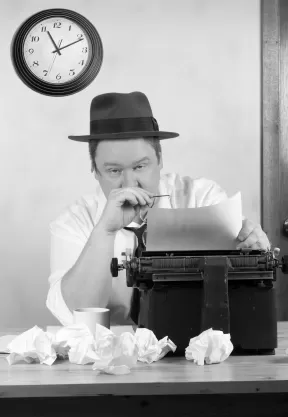It’s hard to get an early start on a proposal, and not just because you don’t know when the RFP will be released. You often get advance notice of RFP releases. When the pursuit is a recompete, you can anticipate the release years in advance. If it's the result of a sources sought notice, request for information (RFI), customer forecast, or other announcement, you may get a notice a month or so in advance. So what do you do? With the time you have available, how can you maximize your win probability?
How to get started when you have ample advance notice
Companies often research pursuits like they are fishing. They see what they can find out. Sometimes they get some bites, but often all they get are nibbles and catch nothing. This tends to result in intel full of generalities and broad concepts that may have little, and sometimes no, impact on what gets written in the proposal.
The entire sales process should be about closing the sale. In effect, this means the entire sales process is about proposal writing. Only instead of the act of proposal writing, it’s about preparing to be able to write the winning proposal. Your business development staff may not participate in proposal writing. But they play a critical role in informing proposal writing, and that has a major impact on the win or loss.
Great proposal writing doesn’t fabricate the message and the proof points out of nothing. It requires information about what messages matter to the customer and the details to substantiate those messages. What defines “What it will take to win?” for a given pursuit? It shouldn’t be things your proposal writer just made up based on what they saw in the same RFP all of your competitors have. Proposal writers merely help articulate your messages based on the information you provide. Closing your leads with a winning proposal requires your lead generation and pursuit staff to deliver an information advantage to your proposal writers.
But what information is that? And where can you get it? Winning a pursuit starts with research. And that research starts by asking the right questions. Those questions should form the basis of your pre-proposal pursuit process. When we created the information advantage sufficient for winning. When we moved that process online and created MustWin Now, we made it even easier to collect the answers and turn them into something that can drop right into the proposal.
How to get started when you have a little advance notice
Sometimes you are lucky to get a month or two’s notice of an opportunity to bid. It’s probably too late to get deep intel about the customer or the opportunity. Maybe you can scope out the competition, but you probably won’t be able to do a very deep assessment, or even identify all of the players. You may need to jump right into finding potential teaming partners, with limited intel and opportunities.
You have very little time for research and the customer is far less likely to share anything of substance with you that they don’t share with everyone bidding. You need to focus more on what matters about the information you have. What matters about it that could impact what you have to say:
• In the technical proposal?
• In the management proposal?
• About your staff?
• About your experience?
• About your qualifications?
Don’t drill all the way down to everything you should say. Don’t try to write the sections. You can’t finish the wording of the proposal until you have the wording of the RFP. But you can figure out things that matter about each of these sections and determine how you should position against what matters to the customer. This will be a huge accelerator when proposal writing starts and will provide the information the proposal writers need to turn a simple compliant response into a compliant response that will be better than your competitors.
How to get started with no advance notice
When you start the proposal at RFP, you have to work with the information you already have. But what is that? And how many people can contribute to it? This is another place where you need to ask the right questions. Most of them won’t get answered, because you don’t have time for research. But you still need to ask.
However, those question are a bit different from when you are starting with advance notice. You need to ask questions that:
- Don’t require research. They should be questions about what you know instead of what you can find out.
- Are specific to the proposal. These are things like what past performance references should you use, what staff will be bid, who is on the team, etc.
You also need to know what matters about the answers. Think in terms of the “So what?” test. If you have the name of the project manager you intend to bid, so what? What matters about having that person to the customer?
One of the ways we enhanced the MustWin Process after we launched it was to add Proposal Input Forms. We created them by modifying our Readiness Review questions to meet the needs described above.
How to turn what you know into a winning proposal
What do you do with this information once you’ve gathered it? You shouldn’t assume that proposal writers will be able to read it, assess it, and remember to incorporate it everywhere it can have a positive impact while writing a response to all the RFP requirements.
What you should do is design things so that the answers drop right into your turn your answers into proposal win strategies and themes, and then allocate those to the proposal outline and then automatically generate a proposal content plan. As soon as the cross-referencing is done, you have a content plan. And you can then click through to each section and add even more guidance. The result is that your proposal writers start creating the narrative proposal with everything they need to write a great proposal on the very first draft.



Join the conversation
You can post now and register later. If you have an account, sign in now to post with your account.